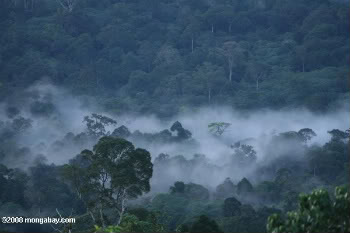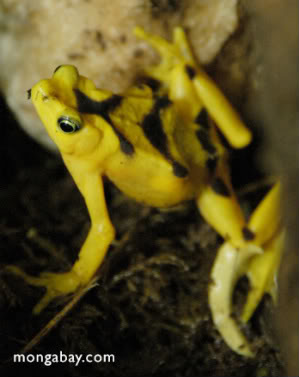Renowned scientists discuss threats to rainforests at symposium
A symposium hosted by the Smithsonian Institution set to debate the threat level posed by deforestation to rainforests, shifted topic slightly near its end as scientists discussed which is the most significant threat to tropical forests and their species: habitat destruction or climate change?
Prominent biologist Joseph Wright, who has come under fire for saying that warnings about habitat destruction in rainforests are exaggerated, passionately argued that climate change is the greatest threat to rainforests.
“Climate change, I believe, is a much greater threat to biodiversity in the tropics than habitat destruction,” Wright said as he began his presentation to a nearly full auditorium at the National Natural History Museum.
 Mist rising in the forest of Borneo. Will this forest survive the double onslaught of deforestation and climate change? |
Wright said that current “conservative” predictions showed that temperatures in the tropics would rise by 3 degrees Celsius by the end of the century. While this may not seem like much, especially compared to predictions for the Arctic, Wright stated that “tropical species are much more sensitive to small increases in temperature than temperate species”. In addition, he presented information that showed how tropical species would have to travel much greater distances than temperate species to find habitat within their normal range of temperatures. Wright called these two factors—greater sensitivity to temperature change and larger migrations for suitable habitat—a “double whammy” for tropical species.
Pointing to recent studies, Wright said that rising temperatures in the tropics have already been linked to a decline in the growth rate of trees in tropical forests in Panama and Malaysia. At the same time the temperature rise has caused greater production of lianas, fruits, and flowers in the forest. One theory is that warmer temperatures are causing plants to spend more energy on the production of fruits and flowers and less in wood production and growth. In turn, the plants are sequestering less carbon. By the end of the century, Wright predicted, the aggregation of such processes will cause rainforests to become a “novel climate” with temperatures similar to those in deserts but still receiving the requisite rainfall for tropical forests.
Extinctions are already occurring across the tropics due to climate change, Wright said, citing the loss of numerous frog species due to the infectious and lethal fungal disease, Chytridiomycosis. The disease has been linked by some scientists to climate change. Calling the extinction in the wild of 165 frog species due to this disease “a mass extinction of tropical montane frogs”, Wright emphasized that he believes global warming will affect the tropics more than any other ecosystem.
 One-by-one populations of the Panamanian Golden Frog were attacked by Chytridiomycosis. In 2008 scientists took drastic action and removed all remaining frogs from their natural habitat, making the species extinct in the wild. Their only hope now are individuals in captivity and a cure for the fungal disease. |
“The polar bear is getting all the attention which I don’t understand,” Wright said near the end of his lecture. “The polar bear is still with us; 160 frog species are no longer with us”.
Tropical biologist William Laurance did not disagree with Wright about the dangers posed by climate changed, but repeatedly emphasized that scientists, conservationists and leaders could only ignore habitat loss at their peril.
“I would argue that habitat destruction is what we should focus on,” Laurance stated definitively.
Other scientists, such as Gregory Asner from the Carnegie Institute and Thomas Rudel from Rutgers University, supported Laurance by showing that deforestation was still on the rise and that the major drivers of deforestation had changed from subsistence farmers to global corporate and industrial interests, which level forests and keep them from re-growth with great efficiency.
“Pressures on land are not going to diminish” Laurance concluded, while not ignoring the threat of climate change. In fact, Laurance argued that preserving habitat from deforestation would also be the most effective way of combating climate change. By protecting habitat one was essentially working toward two goals: climate change mitigation and the preservation of vital ecosystems. Finally, Laurance stated that large reserves of pristine habitat would be required in the future to buffer species from the worst impacts of global warming. Such preserves must continue to be established and monitored.
Ironically Wright, who has been accused by some of naivety and dangerous optimism due to his views on rainforest loss, proved the most pessimistic of the panel when it came to the rainforest’s future. Predicting that climate change would forever alter the ecosystem of rainforests, Wright said that “we have no way to predict what it will look like” or how many species would be able to adapt to even a small rise in temperature in the region. Wright told the audience that they should think of today’s tropical forests like the lost ecosystems of America, such as the vast forests that Europeans found upon arrival in the 16th Century or the Great Plains once filled with bison, antelope, and top predators.
“Today it is still possible to see such [intact] ecosystems in the tropics”, Wright said, encouraging the audience to visit tropical forests before, like the temperate forests of North America and the Great Plains, they are changed inalterably and much is lost.
Wright saw no possibility of preserving rainforests as they are today: “it is going to happen—it is going to change”.
Cristian Samper, director of the National Museum of Natural History and moderator of the symposium, attempted to inject some optimism into the proceedings by noting that humans “have the capacity to change their behavior” and that he believed he saw the beginnings of such behavioral changes already occurring. “I think we are close to a tipping point as a society,” Samper said encouragingly.
While Laurance and Wright did not agree on the most pressing issue or the best way to move ahead, afterwards many audience members said the symposium showed that neither climate change or habitat destruction could be ignored if rainforests are to survive.
Previous articles
Just how bad is the biodiversity extinction crisis?: A debate erupts in the halls of conservation science
(02/06/2007)
In recent years, scientists have warned of a looming biodiversity extinction crisis, one that will rival or exceed the five historic mass extinctions that occurred millions of years ago. Unlike these past extinctions, which were variously the result of catastrophic climate change, extraterrestrial collisions, atmospheric poisoning, and hyperactive volcanism, the current extinction event is one of our own making, fueled mainly by habitat destruction and, to a lesser extent, over-exploitation of certain species. While few scientists doubt species extinction is occurring, the degree to which it will occur in the future has long been subject of debate in conservation literature. Looking solely at species loss resulting from tropical deforestation, some researchers have forecast extinction rates as high as 75 percent. Now a new paper, published in Biotropica, argues that the most dire of these projections may be overstated.
Extinction, like climate change, is complicated
(03/26/2007)
Extinction is a hotly debated, but poorly understood topic in science. The same goes for climate change. When scientists try to forecast the impact of global change on future biodiversity levels, the results are contentious, to say the least. While some argue that species have managed to survive worse climate change in the past and that current threats to biodiversity are overstated, many biologists say the impacts of climate change and resulting shifts in rainfall, temperature, sea levels, ecosystem composition, and food availability will have significant effects on global species richness.
Past climate change may have fried rainforests: From icehouse to hothouse: Melting ice and rising CO2 caused climate shift
(02/18/2007)
Three hundred million years ago, Earth’s climate shifted dramatically from icehouse to hothouse, with major environmental consequences. That shift was the result of both rising atmospheric carbon dioxide concentrations and the melting of vast ice sheets, new research by University of Michigan paleoclimatologist Christopher Poulsen shows.
Climate change will damage forests, creating hardship for rural communities
(11/28/2008)
Climate change will transform forests that directly sustain nearly one billion people, warns a report to be released next week at the United Nations Framework Convention on Climate Change (UNFCCC) meeting in Poznán, Poland.













